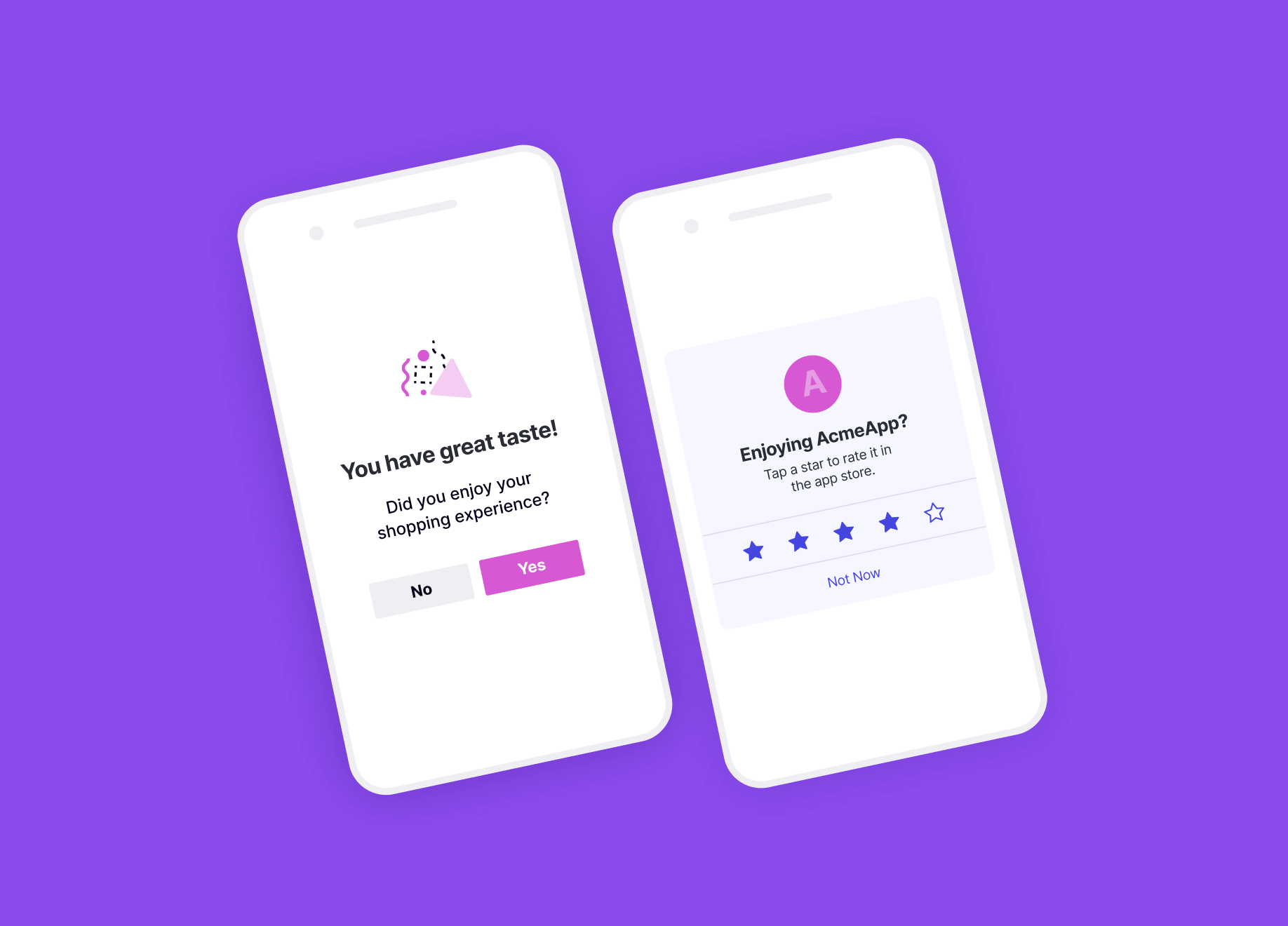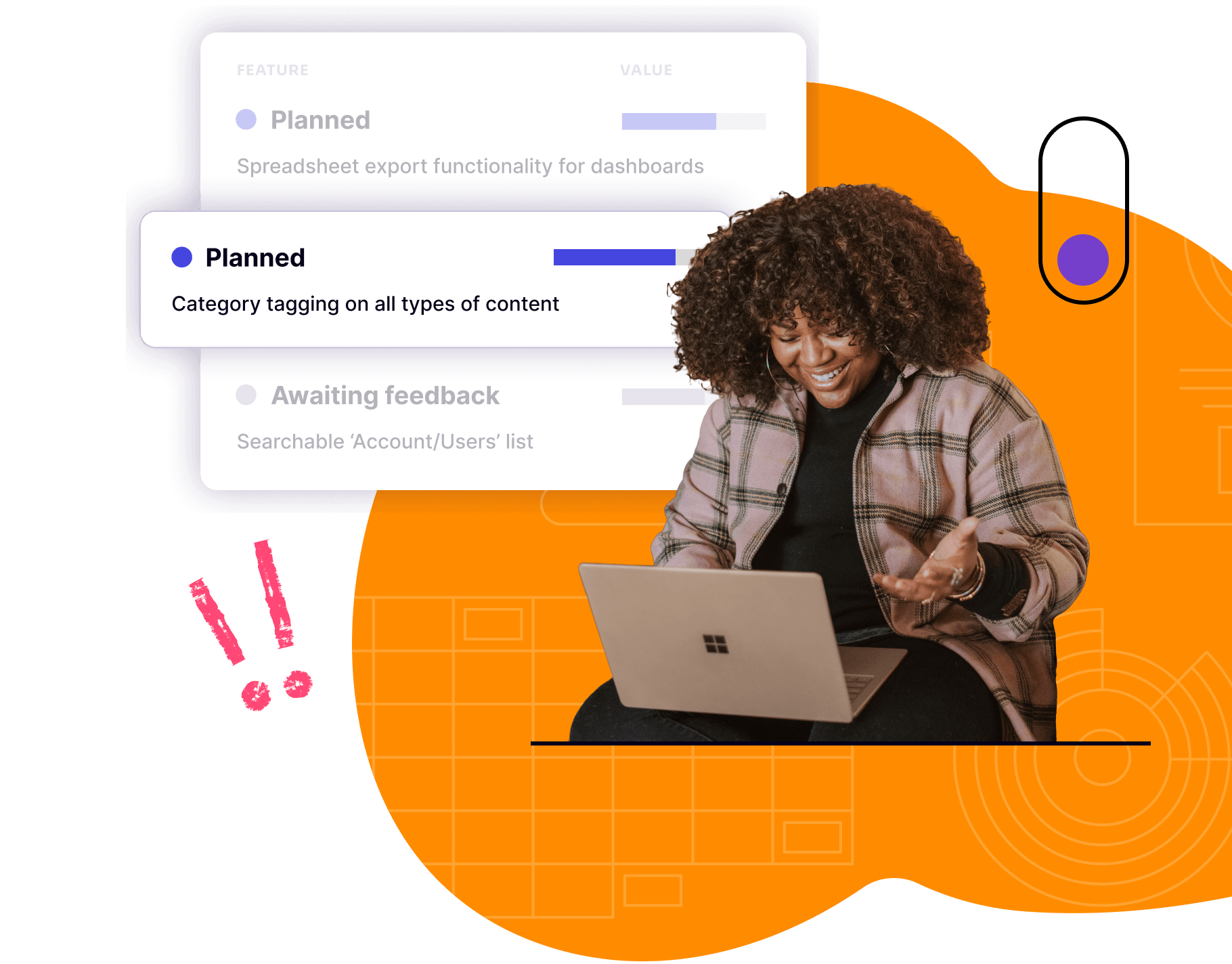
DEEP DIVE - 10 min read
Customer feedback
Information provided by customers about their experience with a product or service.
Dive deeper
Table of Contents
What is customer feedback?
Customer feedback is information provided by customers about their experience with a product or service. Its purpose is to reveal their level of satisfaction and help product, customer success, and marketing teams understand where there is room for improvement. Companies can collect customer feedback proactively by polling and surveying customers, interviewing them, or by asking for reviews. Teams can also passively collect feedback by providing users a place in the product where they can share comments, complaints, or compliments.
Why is customer feedback important?
Without customer feedback, a company will never know if customers are getting value out of their product. Without knowing if they’re getting value, the product and go-to-market teams won’t know if they’re nurturing loyal customers (not to mention be able to measure customer retention and customer health). And without loyal customers, well…
According to Gartner, “customers’ salient experiences with the company heavily influence their long-term switching behavior and reflect the true drivers of loyalty.” How does one find out what these salient experiences were? Through customer feedback.

What are some best practices for collecting customer feedback?
Before you start collecting feedback from customers, it’s important to establish clear processes and service-level agreements (SLAs). For example, you should determine where the feedback will be stored, decide who will be responsible for managing it, develop workflows around how it will be triaged, and set clear expectations with customers so they know how it will be used.
The following tips are a great place to start, particularly if you’re setting up a customer feedback program for the first time.
Get your feedback data in one place
If your customer feedback data is spread throughout multiple platforms and places (e.g. spreadsheets managed by disparate teams, content management systems, etc.), there’s no easy way to spot trends or identify themes. You’re also far more likely to feel overwhelmed by (and therefore never use) the feedback you’ve collected—leaving it to get lost in a dreaded black hole of unaddressed feedback.
The tools or systems you decide to use to manage and synthesize all your customer feedback data will largely depend on your organization’s overall goals and stakeholders, the size and scope of your team, and how you plan to use—and close the loop on—feedback submitted by customers. Ask yourself what you really need your centralized feedback hub to do: Are you a small organization that could get by with a spreadsheet or Trello board as you get started? Or would a more comprehensive system like Pendo Feedback allow you to scale and sustain your efforts?
While centralizing all your customer feedback is crucial for identifying trends and themes, it’s also extremely valuable for collecting one-off or “fringe” requests. Documenting these lesser-known areas for improvement helps you keep an eye out for similar comments down the road, and can serve as a rich source of inspiration your product team may not otherwise have considered.

Agree on a feedback management process
Collecting and acting on customer feedback is not often a one-team job. Particularly in large or enterprise-scale organizations, feedback comes from myriad sources and is touched by many departments. So it’s important to establish a clear feedback management and sharing process that allows you to organize and keep a steady pulse on all that incoming feedback, across all areas of the company. This is also a good opportunity to think about how you’ll share relevant insights with various teams across the business.
For example, as the frontline of your business, customer success managers (CSMs) are privy to requests and feedback from customers that your technical teams (who likely don’t get much face time with customers) aren’t. Your CSMs can help your product and engineering teams understand whether a specific feature request is truly urgent and far-reaching—causing numerous accounts to become at-risk—or if it’s a cosmetic request that isn’t actually mission-critical. Creating a clear strategy for how these kinds of findings will be disseminated across the business is critical for avoiding the dreaded feedback black hole.
It’s also important to set up frequent syncs with all the teams receiving and touching your customer feedback data. Getting these groups aligned on feedback trends—and which initiatives are being actioned on the product roadmap—enables stakeholders to make more informed product decisions and have more productive business discussions.
Write and share a product feedback policy
A product feedback policy is a critical—but often overlooked—element of any good Voice of the customer (VoC) or customer feedback program. It ensures that everyone (both internal team members and customers alike) understands how they can submit feedback, why their feedback matters, and how their feedback will be managed and used. Setting these clear expectations up front goes a long way towards creating accountability, mitigating potential confusion or frustration, and building trust.
If you’d like to create your own product feedback policy, try starting with this template and reviewing Pendo’s take on product feedback.
What is the best way to collect customer feedback?
The best way to collect feedback is to meet your customers where they are: inside your product. Capturing feedback and requests directly inside your app results in higher response rates and engagement (since customers don’t need to take any extra steps to get to an external feedback submission page or portal), and better quality feedback (since they’re responding within the context of the product, as they’re experiencing it. There are several ways you can use Pendo to capture both quantitative and qualitative customer feedback, in-app.
1. In-app surveys and polls
With Pendo, you can collect both quantitative survey and poll data (e.g. Net Promoter Score (NPS) surveys, Customer Satisfaction (CSAT) surveys, or app store ratings) and rich qualitative responses or requests—or even better yet, a combination of the two.
In addition to higher response rates, the ability to keep an ongoing and consistent pulse on customer sentiment, and better quality experience insights, gathering this data inside your product enables you to control the timing and cadence of your surveys and polls. For example, if you’d like a customer to submit an app store rating, ideally, you should try to ask them about their experiences following a positive interaction with your product. Using Pendo, you can define the right behavioral triggers so that your customer is only served the survey after they successfully complete a workflow—rather than via an email or other external channel you can’t orchestrate.

2. Resource Center
The best VoC programs capture both active and passive customer feedback. Passive customer feedback allows customers to submit their thoughts and requests whenever it’s most convenient for them. Not only does this self-service model allow customers to control when and how they share feedback, but it also allows you to keep an ongoing pulse on requests and to gather input about the product or customer experience you may not have considered or previously included in other, more targeted feedback collection programs.
A Resource Center is a great way to give customers an always-available avenue for submitting feedback (or staying abreast on product updates, revisiting onboarding guides, and easily accessing other useful support resources), directly within the context of your product or app. Adding Pendo Feedback to the Resource Center also allows customers to vote for and view in-app requests, helping to close the feedback loop and keeping users in the know about what’s coming next.

How can I improve my customer feedback strategy?
- Make it timely: Emailing a survey to a user may be asking more than they’re willing to give, especially because reading the email pulls them out of the product. Instead, survey them in-app so they receive the question while they are using the product. In-app surveys yield more accurate feedback and typically have higher response rates.
- Make it easy: Collecting feedback should be done on the customer’s terms, not the company’s. What does this mean? Well, if a customer has to dig around in the product to find a “contact us” form, then it’s not exactly easy for them to provide the feedback the product and marketing teams covet. An occasional survey is also not enough. Effective programs make the feedback mechanism as simple as possible, available to any customer, any time.
- Make it smart: Customers should be able to rank their feedback priority—let them share what is most pressing for them, so that product, marketing, and customer success teams can better prioritize their actions. The product team should also be able to search and segment feedback data to better understand any patterns. At Black Diamond, the team sorts feedback by client type and revenue to see if similar accounts are having comparable issues, and then prioritizes accordingly.
- Close the loop: Too often, companies collect feedback, but it ends up in a black hole, never to be synthesized or acted upon. Make sure the company has a clear vision and process in place before collecting feedback, as well as a tool to collect, prioritize, and manage feedback.
Acting on customer feedback
You’ve created a feedback collection strategy, consolidated all your data, and are actively collecting input from customers. Now what? Feedback execution strategies vary from organization to organization—depending on goals, business models, and team structures—but should generally follow these guidelines.
1. Pair qualitative and quantitative data
While product teams of the past have historically relied on anecdotal feedback and gut instinct, that no longer cuts it today. To build the best products possible, companies need data that paints a complete picture of the customer experience. With Pendo, you can bring your product analytics and usage data together with incoming feedback from users—so you can not only see how users are engaging with your product, but also understand what they think about that experience and why they’re using it that way.
Pairing qualitative feedback with quantitative data (like product usage and user metadata) is easy in Pendo. For example, when you view requests, you can also see contextual data about your customers at the user or account level (e.g. if they’re a free user vs. paying customer, how active they are in the application, etc.).

2. Understand urgency and quantify impact
Once you’ve started to identify and group themes in your feedback data (for example, through NPS Insights and synthesis), it’s important to understand the urgency of each request—and its associated value. This will help ensure that your product and development teams are focused on the right initiatives or features that will drive desired outcomes for the business—not just requests coming from the loudest voices in the room—while satisfying your most important or valuable accounts. In Pendo, you can sort requests by account value or number of votes to better identify which areas prioritize and focus on.
3. Connect data to your roadmap
For product teams in particular, the roadmap is your North Star: The future state you’re working towards and the strategic direction you’re steering your product (and by extension, the company) in. Product analytics and customer feedback have an equally important role to play when it comes to informing your roadmap. And without them, you run the risk of devolving your roadmap into a reactive punch list of features—rather than an anchor of your company’s long-term strategy.
Using customer feedback to inform your roadmap is crucial for prioritizing engineering time, making the case for additional resources, and validating items already on your roadmap. This insight is also critical for understanding which products or features are underutilized or aren’t adding value for your customers (and why they feel that way)—so you can make more informed decisions about where you should continue to invest your time and energy.

4. Close the loop
Even if your organization decides not to pursue a feature or request submitted by a customer, it’s critical to close the loop. Customers will quickly lose trust in your brand if they regularly share their thoughts but never hear back from you—regardless of whether you’ve decided to act on their feedback or not. With Pendo Feedback, you can easily automate this process and send a short message to your users whenever the status of their request changes.

And regardless of whether you’re managing your feedback in spreadsheets or in a scalable system like Pendo, a Product Feedback Policy is one of the best and most efficient ways to set clear expectations with your customers from the start. This policy sets clear standards that tell them exactly what to expect once they hit “submit” on their feedback—including when they might hear from you, how you plan to manage and use their feedback, and the benefits of sharing their input.
You might also like


